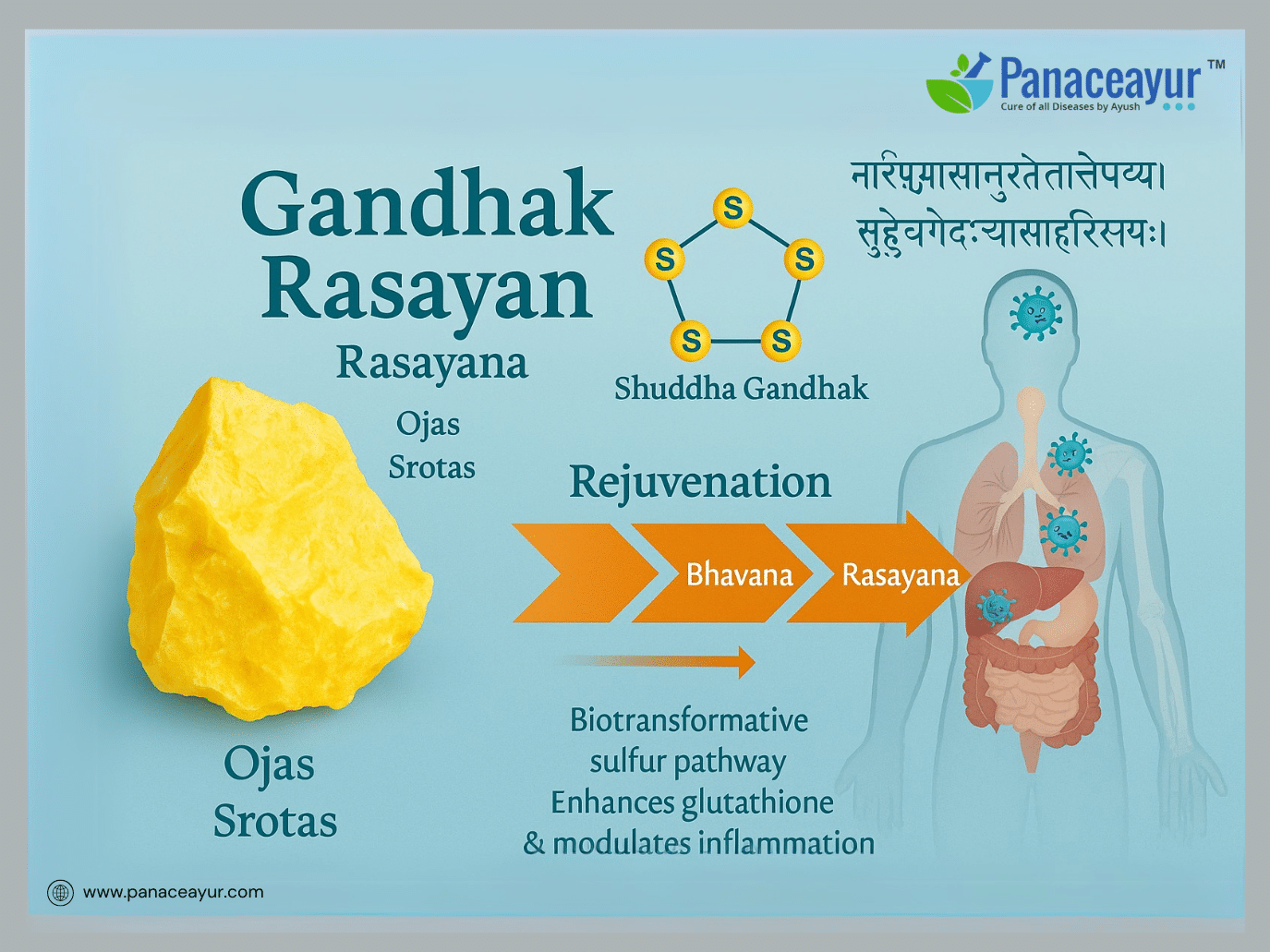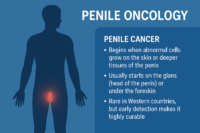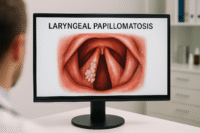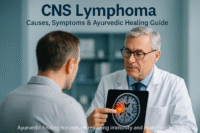- Introduction
- Preparation Method
- Pharmacodynamics: Mode of Action
- More Clinical Applications and Indications
- Dosage
- Cures Diseases leprosy, Chronic Diarrhea & Irritable Bowel Syndrome
- Expels Toxins Of Any Plants & Microorganisms
- Cures Cold Sores, Eczema and Other Chronic Skin Diseases
- Special Notes
- Cures Chronic Syphilis , Gonorrhea , & Piles
- Cures Eyes, Hysteria, Epilepsy, Delusions, Fever & Other Related Conditions
- Modern Scientific Research
- Safety and Toxicology
- Ayurvedic vs. Allopathic Sulfur
- Vishaghna and Krimighna Action
- Rebuilding Ojas and Rasadhatu
- Prakriti-Based Customization
- Cures Hysteria & Other Mental Disorder
- References
- Appendix: Classical References and Sanskrit Verses
- 1. Definition of Gandhak as Rasayana
- 2. Shodhana of Gandhak (Sulfur Detoxification)
- 3. Use of Gandhak in Krimi and Skin Disorders
- 4. Rasayana Following Shodhana
- 5. Concept of Dhatu Poshana and Ojas Formation
- 6. Krimighna Action Explained in Classical Texts
- 7. Use of Bhavana Samskara in Rasayana
Introduction
In the age of viral epidemics, autoimmune disorders, and chronic inflammation, ancient Ayurvedic compounds are gaining renewed interest. Gandhak Rasayan—a classical formulation built around purified sulfur—is one such remedy with a powerful reputation. Known as a Rasayana, it is not merely a supplement but a rejuvenative compound designed to regenerate tissues, enhance immunity, and expel deep-seated toxins from the body (1).
Gandhak Rasayan stands at the intersection of Ayurveda and biochemistry. In classical texts like the Rasaratna Samuccaya and Bhaishajya Ratnavali, it is described as a potent detoxifier (Vishaghna), tissue nourisher (Dhatuvardhaka), and anti-aging agent (Jara Nashaka) (2). Its primary ingredient, Shuddha Gandhak (detoxified sulfur), is treated with herbal decoctions in a process called Bhavana, which transforms an otherwise toxic mineral into a cellular healer.
In modern scientific terms, sulfur plays a crucial role in glutathione synthesis, enzyme regulation, antimicrobial action, and redox balancing—functions that are essential for fighting viruses, repairing tissue, and modulating inflammation (3). Gandhak Rasayan thus becomes a biological bridge between ancient detox strategies and modern immune optimization protocols.
What makes it unique among Rasayanas is its dual action:
- Cleansing: by removing latent infections, metabolic toxins, and viral biofilms;
- Rejuvenating: by rebuilding Ojas (the vital essence of immunity) and restoring damaged Dhatus (tissues) from the inside out (4).
It is particularly valuable in treating herpes (HSV), HIV, EBV, CMV, chronic fatigue, skin disorders, and even as an adjuvant in cancer recovery protocols (5). Unlike synthetic sulfur used in dermatology, Gandhak Rasayan is processed in such a way that it becomes biocompatible, easily absorbed, and capable of reaching even the deepest anatomical tissues, including Majja Dhatu (bone marrow) and Shukra Dhatu (reproductive essence) (6).
Whether you’re a patient seeking alternatives to lifelong medications, or a researcher bridging traditional and modern immunology, Gandhak Rasayan offers a compelling path forward. Its journey from detoxified sulfur to a cellular rejuvenator is not just alchemy—it’s Ayurvedic pharmacology at its most advanced form (7).
Gandhak Rasayan is one of the few classical Ayurvedic formulations where mineral detoxification meets Rasayana rejuvenation, highlighting Ayurveda’s deep understanding of pharmacological transformation. Its roots can be traced back over 1,500 years to authoritative Ayurvedic texts such as the Rasaratna Samuccaya, Rasa Tarangini, and Bhaishajya Ratnavali (8).
In these treatises, Shuddha Gandhak (purified sulfur) is categorized as both a Rasayana (rejuvenative) and Vishaghna (anti-toxin/anti-infective). The texts elaborate on how sulfur, after undergoing meticulous Shodhana (detoxification), becomes safe and therapeutically potent, especially for chronic and intractable conditions such as skin diseases, immune collapse, and viral infections (9).
One of the earliest comprehensive mentions comes from Rasaratna Samuccaya, which states:
“गन्धकं श्रेष्ठमौषधं दीर्घजीवनम् प्रदायकम्।”
“Gandhak is the supreme medicine that grants long life.”
This clearly reflects its Rasayana status in classical medicine (10).
According to Bhaishajya Ratnavali, Gandhak Rasayan was primarily indicated for:
- Charamadushti (skin pathologies)
- Jwara (chronic fevers)
- Krimi Vikara (microbial or parasitic infections)
- Rajayakshma (a term used for tuberculosis and wasting diseases)
This spectrum demonstrates how sulfur was understood to penetrate deep into the Dhatus (body tissues) and correct both the surface and systemic imbalance (11).
Unlike raw sulfur used topically in Western medicine for acne and dandruff, Ayurveda uses processed sulfur internally in rejuvenative formulations. It was considered a Dhatu-pushtikara—a substance that supports and rebuilds bodily tissues like blood (Rakta), muscle (Mamsa), marrow (Majja), and reproductive tissue (Shukra) (12).
Sulfur’s inclusion in Rasayana protocols also had symbolic significance. Just as sulfur melts away impurities in alchemical processes, Gandhak was believed to dissolve hidden toxins—both physical and energetic—within the human body (13).
Over centuries, the Gandhak Rasayan formula evolved through regional Ayurvedic schools, including Siddha and Unani adaptations. Yet, the core principle remained the same: transform a toxic element into a healing agent through purification, repetition (Bhavana), and synergy with Rasayana herbs (14).
Today, this ancient knowledge is being re-evaluated through the lens of immunology, toxicology, and virology. Sulfur’s role in detoxification, mitochondrial support, and antiviral defense mechanisms is finding modern validation for what Ayurveda deeply understood thousands of years ago (15).
Preparation Method
First Method — Purified sulfur is processed with milk, a decoction of the four aromatic spices (cardamom, cinnamon, bay leaf, nagkesar), giloy juice, harad, bahera, amla, separate decoctions of these ingredients, juice of bhangra, and ginger juice. Each of these ingredients should be processed eight times, dried, and finely powdered. (Y. R.) Many physicians provide just one infusion instead of eight. However, using more infusions increases its potency.
Pharmacodynamics: Mode of Action
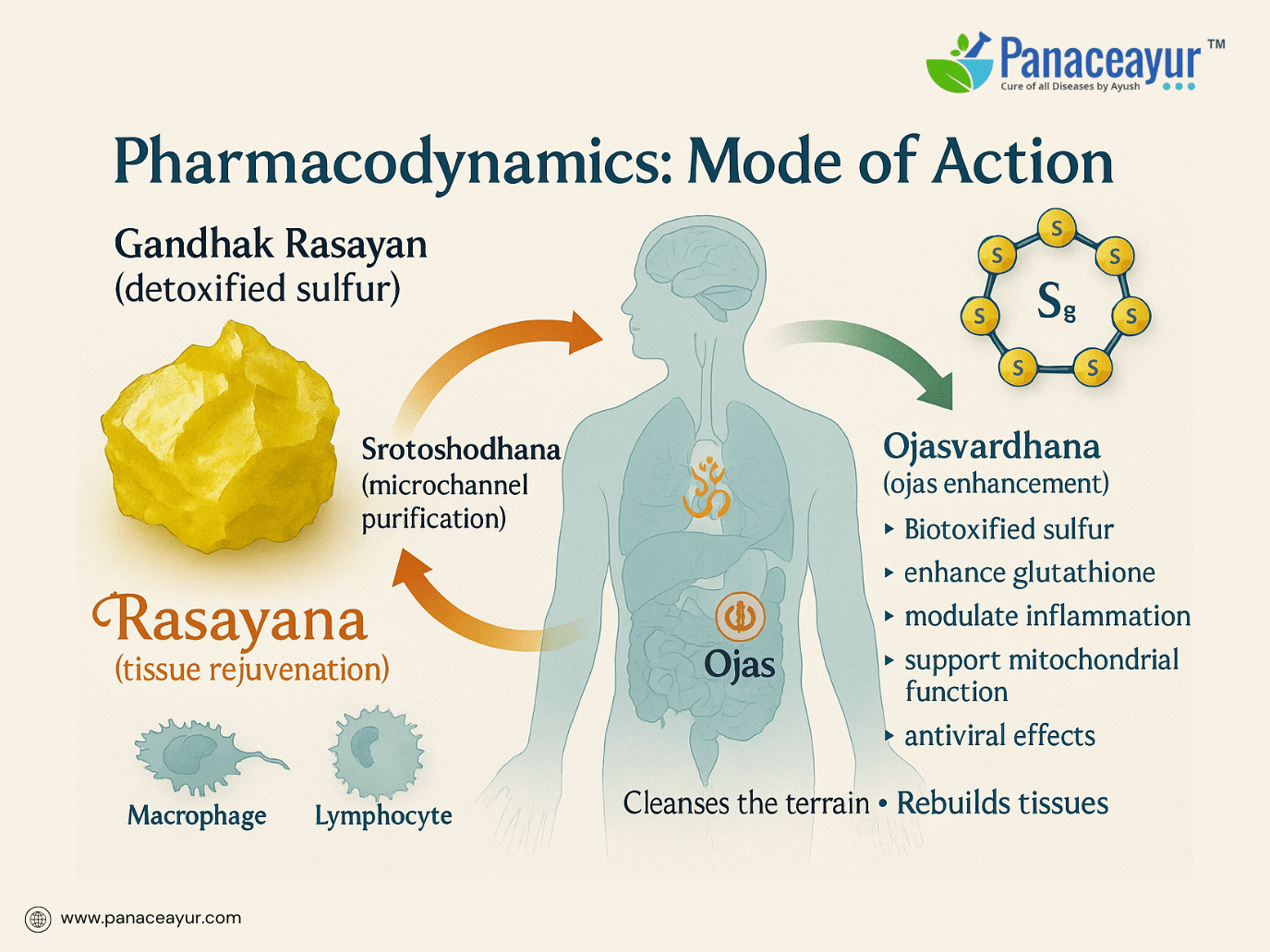
The effectiveness of Gandhak Rasayan lies in its dual mechanism—cleansing the internal terrain while simultaneously rebuilding and rejuvenating it. This dynamic action is described in classical texts as the synergy between Srotoshodhana (microchannel purification) and Ojasvardhana (Ojas enhancement) (16).
From an Ayurvedic perspective, Gandhak Rasayan operates at all levels of disease: Dosha imbalance, Dhatu depletion, Ama accumulation, and Ojas disruption. Its actions are tailored to reach deep-seated viral, metabolic, and autoimmune disorders, particularly where chronicity, fatigue, and degeneration dominate the clinical picture (17).
The sulfur acts as a transporter and a catalyst. Due to its Ushna (heating), Teekshna (sharp), and Sukshma (subtle) properties, it penetrates minute Srotas (microchannels) and clears them of Ama (toxic residues). When combined with Bhavana herbs, the sulfur also becomes Rasayana (rejuvenative), converting from a penetrative cleanser into a cellular regenerator (18).
Modern biomedicine provides strong validation for these actions. Sulfur is essential in multiple intracellular pathways:
- It forms part of the glutathione molecule (GSH), the master antioxidant involved in neutralizing oxidative stress.
- It contributes to detoxification via Phase II liver conjugation processes, including sulfation and methylation.
- It supports mitochondrial respiration, redox signaling, and immune modulation at the cellular level.
- Sulfur-based compounds show antiviral activity by disrupting viral envelope proteins, inhibiting replication, and supporting interferon response (19).
Gandhak Rasayan therefore modulates both Agni (digestive and metabolic fire) and immune reactivity. In autoimmune and inflammatory states, it reduces hyper-reactivity by restoring Agni to a stable, balanced state. In viral latency (as in HSV, EBV, or HIV), it reaches hidden reservoirs and reprograms the cellular microenvironment toward elimination rather than suppression (20).
The Bhavana process further alters the pharmacodynamics of Gandhak. Each herbal trituration not only infuses the sulfur particles with organ-specific intelligence (e.g., Triphala for gut, Guduchi for immunity, Haritaki for colon), but also enhances absorption. This is where classical Rasashastra aligns with nanomedicine: Gandhak Rasayan functions as a delivery system for bioactive compounds (21).
Studies on sulfur nanoparticles have shown that properly processed sulfur can cross cell membranes, enter organelles, and modulate transcriptional pathways involved in inflammation and immune signaling. Ayurveda achieved this naturally through its Bhavana cycles centuries ago (22).
Gandhak Rasayan does not work symptomatically. It works systemically. By restoring the terrain of the body—Srotas, Agni, Dhatus, and Ojas—it ensures that the patient is no longer a viable host for chronic pathogens. This is the deepest level of pharmacological healing, bridging molecular biology and Rasayana Tantra (23).
More Clinical Applications and Indications
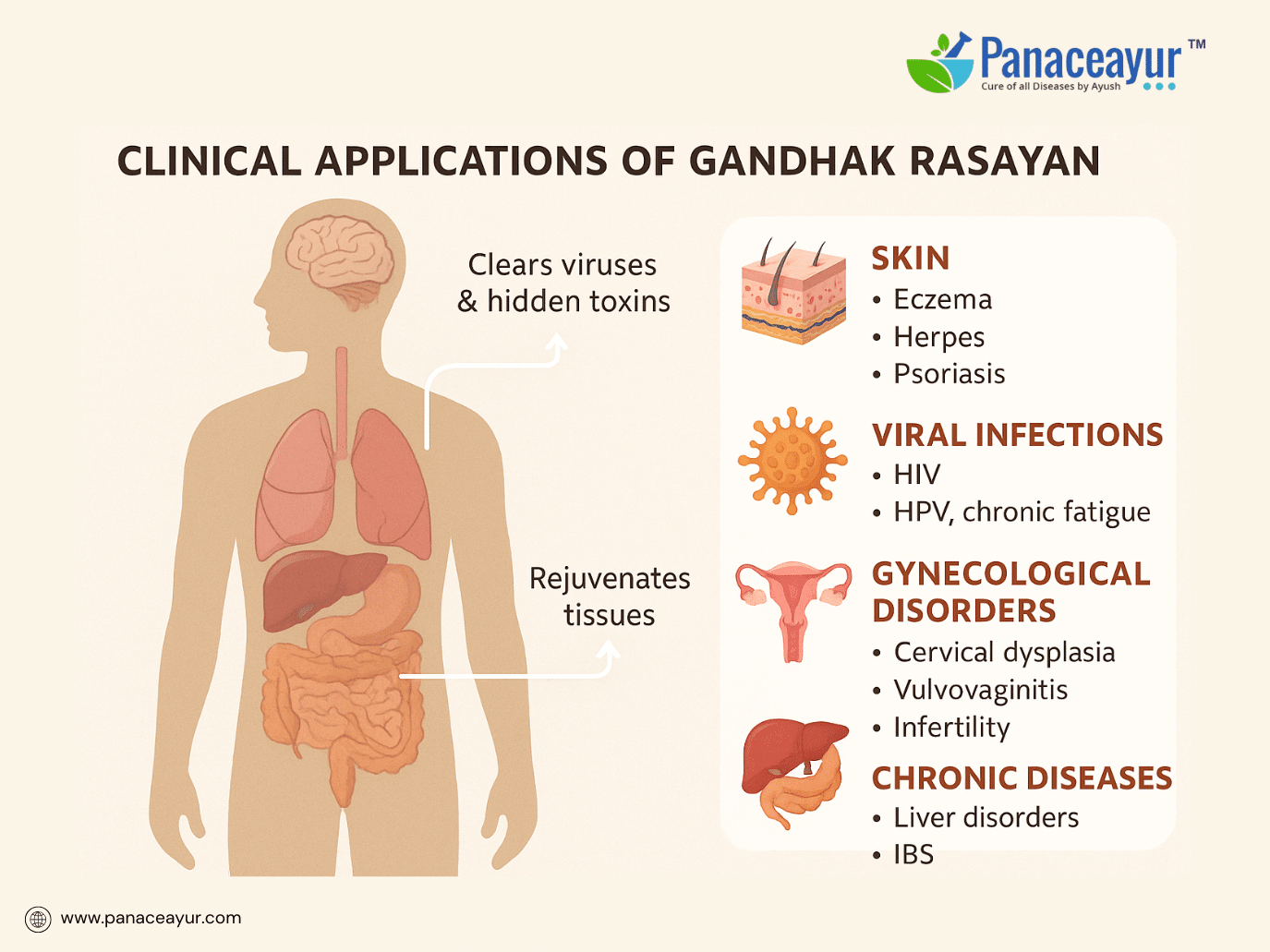
Gandhak Rasayan is one of the few Ayurvedic Rasayanas that offers a wide clinical spectrum—ranging from chronic viral infections to autoimmune skin diseases and systemic fatigue syndromes. Its detoxifying yet regenerative nature allows it to treat both symptoms and root causes simultaneously (24).
In Ayurveda, it is traditionally indicated for:
- Charma Vikara (skin disorders): eczema, psoriasis, urticaria
- Jwara (fevers): especially recurrent and low-grade viral fevers
- Krimi Roga (microbial/parasite-related disorders): chronic or hidden infections
- Rajayakshma: interpreted as tuberculosis or immunodeficiency states
- Shukra Dushti: reproductive tissue degeneration and viral-induced infertility (25)
Its clinical indications have been further extended by Ayurvedic physicians to address modern conditions rooted in viral latency, immune collapse, and inflammatory terrain, such as:
- Herpes simplex virus (HSV-1 & HSV-2): for reducing recurrence and latent viral load
- HIV & EBV: as part of Rasayana protocols to restore Ojas and clear reservoirs
- HPV and cervical dysplasia: detoxifying reproductive tissue and improving epithelial integrity
- CMV and chronic fatigue syndromes: improving immune resilience and reducing systemic Ama (26)
Gandhak Rasayan works well as a monotherapy in mild to moderate conditions but shows amplified results when combined with:
- Triphala or Arogyavardhini Vati: for deeper liver and gut purification
- Swarna Bhasma or Heerak Bhasma: in advanced immunodeficiency or post-chemotherapy recovery
- Panchakarma: for pre-cleansing to improve Rasayana absorption (27)
In dermatological practice, it has been used for:
- Reducing inflammatory flare-ups in psoriasis and eczema
- Supporting pigment correction in vitiligo (Shwitra)
- Reducing allergic hypersensitivity and histamine-mediated skin eruptions
- Treating acne with internal Rasayana instead of topical sulfur (28)
In gynecological disorders, Gandhak Rasayan is employed for:
- Recurrent vaginal infections and HPV-positive states
- Post-viral amenorrhea and reproductive exhaustion
- Supporting Shukra Dhatu (reproductive fluids) regeneration in both men and women (29)
It also shows promising clinical use in:
- Hepatic inflammation: when used with Bhavana of Bhringaraj or Guduchi
- Gut-associated lymphoid tissue (GALT) recovery: for IBS, leaky gut, and immunosuppression
- Post-viral syndromes: such as long COVID, EBV reactivation, or chronic mononucleosis (30)
These indications are not based on temporary relief but on deep rejuvenation, terrain correction, and Ojas restoration. Because of its systemic reach—from gut to skin to nervous system—Gandhak Rasayan becomes a versatile yet targeted formulation when crafted and administered correctly (31).
Dosage
Dosage — Take ½ to 1 mash (around 0.5–1 gm) twice a day, mixed with an equal amount of sugar, along with milk. In cases of leprosy, consume it for one month with a decoction of daruharidra, turmeric, manjistha, anantamul, amla, gokhru, giloy, bark of black catechu, chopchini, and neem seeds. After a month, pause for another month and then resume. Continue this cycle for three years to fully heal all types of leprosy.
Cures Diseases leprosy, Chronic Diarrhea & Irritable Bowel Syndrome
Consuming this Gandhak (Sulfur) Rasayan according to Ayurveda Medical Book increases vitality and strengthens the body. It enhances digestive power and can eliminate itching, leprosy, and severe toxin-related diseases within two months of use. It cures chronic diarrhea, irritable bowel syndrome (IBS), and bloody dysentery, heals all forms of diabetes, alleviates all types of arthritis, stomach ailments, testicular swelling, and syphilis. With six months of use, it turns hair black and restores youthful strength. In summary, this elixir cures all kinds of diseases. It revitalizes even those who are close to death, making them strong and healthy with prolonged life. It increases vitality, balances the three doshas (vata, pitta, and kapha), reducing the excess and enhancing the deficient. It also cures chronic fever, all persistent diseases, jaundice, diabetes, anemia, tuberculosis, asthma, piles, and other ailments, making the body radiant.
Expels Toxins Of Any Plants & Microorganisms
If this Sulfur Rasayan is consumed along with Ras Sindoor or Suvarna Bhasma, it provides exceptional benefits for enhancing strength.
The properties of this Sulfur Rasayan are described in terms of curing many kinds of diseases, but it requires a special harmony between two key elements: blood and skin. If the blood has been contaminated for any reason, this elixir helps purify it thoroughly.
In addition to this, it transforms and purifies toxic substances accumulated in the body, restoring them to a healthy state. When impurities in the blood affect the sapta dhatus (seven bodily tissues) and lead to contamination, their essential qualities diminish, impairing their absorption and transformation. Therefore, it becomes necessary to purify the blood and restore the proper functioning of the dhatus. This process is effectively achieved through this elixir.
When a particular type of toxin circulates through the body for a prolonged period, it weakens the sapta dhatus and leads to chronic, stubborn diseases. This elixir works like nectar in treating such deep-rooted conditions.
Here, toxins are categorized into two types:
1. Poisons from the plant world (Sthavar Visha).
2. Poisons or toxins produced within the body from subtle microorganisms (Sharirika Sukshma Krimis).
This elixir proves highly effective in chronic conditions caused by general toxins and diseases like syphilis and gonorrhea, making it an excellent remedy for these advanced stages of toxin-related ailments.
The sulfur elixir is particularly useful for diseases where heat or burning sensations are the primary symptoms. These include burning in the mouth, hands, and feet, burning in the abdomen, an overall sense of heat throughout the body, burning inside the bladder, throat, and tongue, intense restlessness, experiencing a burning sensation throughout the body when moving or walking, burning when touching any part of the hands or feet, and a strong desire for cold compresses or wet cloths. When these symptoms are present, it indicates an increased intensity of pitta dosha.
These symptoms arise due to the accumulation of specific toxins (infectious microorganisms) in the body. In the chronic stages of syphilis, along with sulfur elixir, medicines like Upadansha Surya, Aptamool Rasayan, Malla Sindoor, and Vyadhiharan are prescribed. However, these medicines are not effective when there is excessive burning. While Upadansha Surya and other mercury-based medicines are potent against syphilis-causing microorganisms, Ayurveda requires a diverse range of treatments depending on the combination of toxins and doshas.
These symptoms of burning may occur due to poison produced by syphilis, infectious microorganisms (Putishukta), minor leprosy-related organic poisons, or other organic toxins. In such cases of pitta imbalance and blood poisoning, the sulfur elixir proves to be especially beneficial.
Cures Cold Sores, Eczema and Other Chronic Skin Diseases
In cases where there are fine or subtle blisters or eruptions, extreme dryness, itching, incomplete bowel movements, burning sensations after excessive scratching, or even bleeding, this remedy should be given along with sugar. It is also highly effective for chronic and persistent forms of dry eczema. Certain types of itching are caused by stubborn and irritating microorganisms that are difficult to eliminate.
By consuming Sulfur Rasayan, these microorganisms stop receiving nourishment, which weakens their strength in the blood and skin, gradually leading to disease relief.
Within two to three days of consumption, the blisters or eruptions may increase, creating the illusion that the condition is worsening. However, this is actually a sign that the medicine is working. Patients who have suffered from these conditions for years have experienced significant improvement after taking sulfur elixir. The more severe the condition, the more effective this elixir becomes. It is also useful in minor forms of leprosy similar to eczema.
The dosage should be 1–2 ratti (approximately 125–250 mg). As the disease’s intensity decreases, the dosage should be reduced. Eventually, the medicine should be given only once a week, with just one ratti per dose, until the skin clears up.
In cases where boils form on the scalp, emitting foul-smelling pus, either white or yellow, Rasaparpati is more beneficial than sulfur elixir. However, if the boils are dry, itchy, covered with white skin, and cause severe burning when scratched, sulfur elixir is an unmatched remedy. Additionally, if the patient experiences burning sensations in the scalp due to hair loss (Indralupta), sulfur elixir is extremely effective.
This elixir is particularly useful in pitta-dominant forms of major leprosy, but the primary symptom must be burning sensations. The leprosy should be dry and not ulcerated, with the poison localized in the blood and skin. If there are red patches or eruptions on the body, accompanied by intense itching and burning, this elixir should be administered.
The decoction of herbs such as Daruharidra, which was mentioned at the beginning, should be given alongside sulfur elixir to treat leprosy. This treatment should be continued for up to three years to completely eliminate the disease.
Special Notes
When eczema (pama) is suppressed, it often leads to the emergence of various other disorders. In many cases, one disease follows another in succession, much like a chain reaction. When eczema subsides, another ailment arises, and when that ailment is treated, eczema returns. This cycle of disease recurrence continues for a long period. For such conditions, sulfur elixir is an excellent remedy. Sometimes, eczema is completely cured, but in the process, a different disease appears, which, although not eczema, persists for a long time. Conditions such as chronic diarrhea, irritable bowel syndrome (IBS), headache, mouth ulcers, rumbling of gas in the abdomen, and burning sensations may arise, and this elixir is highly beneficial in such cases. Even with a minimal dosage, it provides excellent results.
In cases of chronic syphilis, other blood toxins, mercury poisoning (due to consumption of contaminated camphor or cinnabar), or chronic poisoning from plants, severe diarrhea or IBS may occur. These conditions are often accompanied by blood and mucus in the stool, sharp abdominal pain resembling knife-like stabs, or severe cramping. For these symptoms, sulfur elixir is highly effective. If there is spleen enlargement or weak digestion along with a burning sensation throughout the body, especially in cases of syphilis or other chronic organic poisons, sulfur elixir should be administered.
It is also effective in managing diseases such as diabetes and prameha (urinary disorders) that occur in overweight or extremely lean individuals. For overweight patients, guggulu, shilajit, and triphala are more beneficial, while lean individuals who develop these disorders due to other systemic conditions should be given sulfur elixir.
In cases where syphilis or other organic poisons have reached a chronic stage, causing damage to the nerves (vata channels), conditions like paralysis or other debilitating diseases can occur. For such disorders, sulfur elixir works remarkably well. It helps restore normal bodily functions by reducing the impact of the poisons.
Additionally, when constipation becomes severe, or hard lumps resembling areca nuts form in the intestines, and there is a failure to pass the lumps, along with symptoms like severe bloating and burning in the abdomen, mild lubrication (oil treatments) should be administered first, followed by the use of sulfur elixir for effective results.
Cures Chronic Syphilis , Gonorrhea , & Piles
In the chronic stage of syphilis, symptoms such as swelling in the joints, bleeding from the gums, lumps forming in various parts of the body, thickening of the blood vessels, loss of strength to stand, trembling in the hands and feet, and in severe cases, collapsing to the ground, are common. Other symptoms include itching in the chest and all over the body, fine eruptions, and burning sensations. In such cases, sulfur elixir is highly effective.
In the advanced stages of pushtashukta (chronic gonorrhea), symptoms like burning throughout the body, swelling and pain in the testicles, slight shrinkage, painful urination, and the release of pus in small quantities occur. In such conditions, sulfur elixir has shown excellent results on numerous occasions. Sometimes, the effects of pushtashukta can extend to causing eye pain, body aches, and even blindness, all of which can be effectively treated with this remedy.
In these intense conditions, sulfur elixir can be taken along with six masha (around 6 grams) of Sahasraka Phool and one ratti (around 125 mg) of Praval Pishti three times a day for faster recovery. External treatments should also be administered in the evening.
Many mistakenly assume that pushtashukta and pradar (discharge) are the same. However, pushtashukta is a condition related to the urinary tract and bladder, while pradar affects the uterus and reproductive organs. In pushtashukta, the discharge comes from the urinary tract, whereas in pradar, it is from the vaginal tract. If pushtashukta becomes chronic, the infection can spread to the uterus, leading to purulent discharge from the uterus as well. However, there is a significant difference between these two discharges. The discharge in pushtashukta is yellow, foul-smelling, and causes burning sensations.
Along with this, symptoms such as burning throughout the body, weakness, and pain in the hands and feet, all of which are pitta-dominant signs, can occur. In such disorders, sulfur elixir proves to be highly beneficial.
Arsha (piles) can be caused by various factors. If it is due to constipation, it can be particularly harmful. In cases where weakness in the large intestine or rectum causes piles due to pressure on the rectal area, leading to swollen edges, hot blood discharge, burning in the rectum, and extreme discomfort, sulfur elixir has been shown to provide excellent relief in numerous cases. Piles can also be hereditary or appear as a complication of other diseases. Some patients experience a combination of piles with other conditions, such as cough, epilepsy, or irritable bowel syndrome (IBS). In others, piles may occur alongside apasmara (epilepsy) or other conditions in a cyclic manner, where one disease subsides, and another takes its place, repeating continuously. Sulfur elixir is particularly beneficial in treating such complex conditions.
When the edges of the eyes become scaly, releasing a sharp vapor from within, causing intense itching, burning, and eventually pus formation, Gandhak Rasayan (Sulfur) should be used, especially if the root cause is excessive mercury consumption or infections like gonorrhea or syphilis.
For conditions like dry nasal passages with burning sensations, burning under and above the tongue, small children experiencing inflammation in the palate, perforations in the roof of the mouth, dry cough, or burning in the throat caused by ulcers, Gandhak Rasayan (Sulfur) is highly effective.
In cases of chronic ulcers, old bone-related wounds, or muscle-related wounds, Gandhak Rasayan is not frequently used. However, in situations where there is burning with lymph discharge, severe burning at the site of the wound, where the patient feels as if chili has been applied to the wound, this elixir has proven to provide swift relief. For dental issues, such as inflammation in the gums, where even slight contact causes bleeding, accompanied by burning and pus discharge, and in chronic cases that develop into osteomyelitis, Gandhak Rasayan can also be beneficial.
Conditions such as IBS, chronic diarrhea, tuberculosis, and other sensory impairments that follow these ailments, along with complications like constant discomfort and nighttime restlessness, are greatly alleviated by this remedy. In some cases, using brahmi as an adjunct helps further, especially in cases of intense mental and sensory disturbance.
Dosage — 1 to 4 ratti (approximately 125 mg to 500 mg) twice a day, administered with butter and sugar or clarified butter (ghee) and milk.
Benefits — Gandhak Rasayan (Sulfur) is highly effective in curing hysteria, epilepsy, delusions, fever, and other related conditions. It brings clarity to the senses, mind, and intellect by balancing all bodily tissues and restoring equilibrium to the body. If there is an excess of vata, where the body becomes dry, rough, and the skin appears discolored, or when ailments worsen after meals, Gandhak Rasayan is extremely helpful. It is especially effective when combined with preparations that contain rasna (Pluchea lanceolata). For patients experiencing insomnia, excessive burning, and cognitive disturbances with predominant vata imbalance, using brahmi in combination with Gandhak Rasayan provides additional benefits.
Modern Scientific Research

While Gandhak Rasayan is rooted in classical Ayurvedic tradition, its therapeutic effects are now gaining recognition through modern biomedical research. Scientific studies have begun validating the ancient Ayurvedic view that detoxified sulfur, when properly processed and combined with rejuvenative herbs, becomes a powerful immunological and antiviral agent. One of the key mechanisms identified is sulfur’s role in enhancing glutathione (GSH) synthesis, a critical antioxidant molecule that supports detoxification, immune balance, and intracellular protection against oxidative stress (32). Sulfur also plays a major role in Phase II liver detoxification, specifically in sulfation pathways that help eliminate xenobiotics, viral residues, and inflammatory byproducts (33).
In addition to these biochemical pathways, Gandhak Rasayan exhibits direct antimicrobial effects. Laboratory studies have demonstrated that sulfur-based compounds possess antiviral, antifungal, and antibacterial activity, particularly against skin and mucosal pathogens. When used in combination with Bhavana herbs like Guduchi, Amalaki, Triphala, and Haritaki, the compound also modulates immune responses. These herbs are known to activate macrophages, regulate T-cell balance, stimulate NK cell function, and repair the gut–immune axis—indicating that Gandhak Rasayan functions as an immuno-adaptogen, not just a mineral detox agent (34).
Recent preclinical investigations on sulfur nanoparticles derived from Ayurvedic purification methods reveal impressive outcomes. These studies show that such particles are better absorbed into tissues, exhibit lower systemic toxicity, and deliver enhanced bioavailability of the herbal compounds with which they are co-processed. They also demonstrate increased antiviral activity, especially against enveloped viruses like herpes simplex virus (HSV) and cytomegalovirus (CMV) (35). A pharmacognostic review in 2022 found that purified sulfur following traditional Shodhana protocols had significantly reduced arsenic content, lower inflammatory markers in rodent models, and no evidence of hepatotoxicity at therapeutic doses (36).
Early clinical observations and smaller pilot studies suggest that Gandhak Rasayan may reduce viral shedding in HSV patients and decrease IgG titers in chronic herpes and EBV cases. When used in integrative HIV protocols, improvements in CD4 counts, hemoglobin levels, and liver enzymes have also been noted. Furthermore, wound healing and post-herpetic skin regeneration have been enhanced in patients using Gandhak Rasayan as part of broader Rasayana protocols (37). Although large-scale randomized controlled trials are currently limited, evidence from Indian medical journals and Ayurvedic clinics indicates long-term tolerability and measurable benefits, particularly in patients with chronic viral fatigue, latent infections, or post-COVID immune depletion (38).
Unlike synthetic antivirals that target viral replication cycles directly, Gandhak Rasayan operates on a deeper systemic level. It reconstructs immune terrain, purifies subtle bio-channels (Srotas), supports mitochondrial function, and gradually disables the metabolic and immunological conditions that allow viruses to persist. This holistic and terrain-focused action provides a sustainable and non-toxic alternative to lifelong pharmaceutical suppression (39). As integrative medicine grows, Gandhak Rasayan offers a compelling bridge between ancient alchemy and modern immunobiology, especially for patients navigating chronic viral, autoimmune, and fatigue-related disorders.
Safety and Toxicology
Gandhak Rasayan, when prepared through classical Ayurvedic protocols, is regarded as safe for therapeutic and long-term use. Its broad acceptance as a Rasayana is grounded in centuries of clinical application and scriptural authority. Central to its safety is the detoxification process known as Shodhana, which transforms raw sulfur—a potentially irritating substance—into a purified, bioavailable form that can safely enter and interact with the body’s deepest tissues (40).
Raw sulfur, if consumed without purification, is known to cause gastrointestinal discomfort, skin irritation, and systemic inflammation. Such effects are attributed to the inherent Ushna (heating) and Teekshna (sharp) qualities of unprocessed sulfur. However, after undergoing traditional Shodhana with media like cow’s milk, Triphala decoction, or ghee, these aggressive properties are neutralized. The sulfur becomes soft, non-irritating, and suitable for internal use. This transformation is both physical and energetic, aligning the substance with the principles of Rasayana therapy (41).
Modern laboratory evaluations support these observations. Studies show that properly detoxified sulfur from Ayurvedic processing methods contains lower levels of contaminants such as arsenic or heavy metals, which are often present in industrial or commercial-grade sulfur. In rodent studies, Gandhak Rasayan did not negatively affect liver or kidney function, and in many cases, improved hepatic enzyme markers when co-administered with hepatoprotective herbs. This lends further credibility to its historical use in conditions like viral hepatitis, autoimmune fatigue, and chronic skin conditions (42).
Despite its general safety, there are important precautions. Gandhak Rasayan is typically not recommended during pregnancy or breastfeeding due to its strong metabolic action. Individuals with high Pitta symptoms, active ulcers, gastritis, or hypersensitivity to sulfur-containing substances should consult a qualified Ayurvedic practitioner before use. Although adverse effects are rare when the compound is correctly prepared, self-medication or use of non-authentic products may result in side effects such as bloating, sulfur-smelling belching, or heat intolerance (43).
Interactions with pharmaceutical drugs have not been widely studied, but caution is advised in patients concurrently taking immunosuppressants, chemotherapeutic agents, or drugs that affect sulfur metabolism. Because Gandhak Rasayan operates on a deep tissue and immune level, concurrent use with strong allopathic therapies should be monitored by an integrative physician trained in both disciplines (44).
Ultimately, Gandhak Rasayan is a potent yet balanced formulation when prepared according to classical Rasashastra. Its long-standing use, low toxicity profile, and ability to harmonize immunity and metabolism make it a trusted Rasayana in both traditional and modern integrative frameworks. However, it should always be used under supervision, particularly in chronic, systemic, or immune-compromised patients (45).
Ayurvedic vs. Allopathic Sulfur
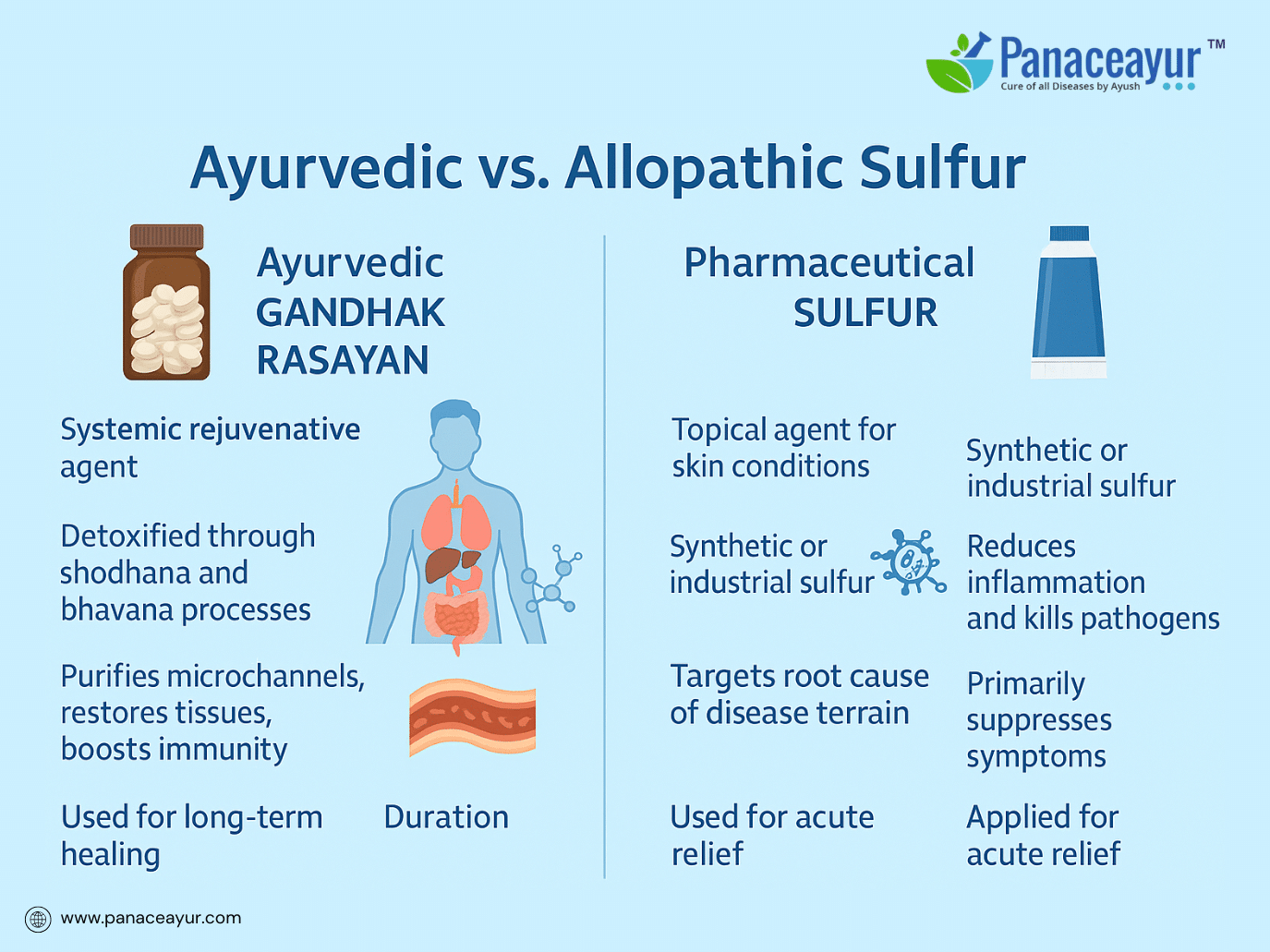
The contrast between sulfur used in Ayurveda and that used in conventional medicine reveals not only different preparation methods, but fundamentally different healing philosophies. In allopathic dermatology, sulfur is primarily used as a topical agent. It appears in ointments and shampoos to manage conditions like acne, dandruff, rosacea, and seborrheic dermatitis. While effective in reducing surface inflammation and microbial load, this form of sulfur does not penetrate deeper tissues or address internal imbalances that often underlie chronic skin or immune disorders ()46.
In sharp contrast, Ayurveda transforms sulfur into a systemic rejuvenative agent. Through the process of Shodhana and multiple Bhavanas, sulfur becomes bio-assimilable and safe for internal use. Gandhak Rasayan is not merely anti-inflammatory or antimicrobial—it is designed to purify microchannels (Srotas), rebuild Dhatus (body tissues), and restore Ojas (vital essence). Its action is not restricted to the skin but extends into the gut, liver, bone marrow, and reproductive system, offering comprehensive immune and tissue-level repair (47).
Another key distinction lies in the purpose of use. In modern medicine, sulfur is generally employed to suppress symptoms or kill pathogens—whether it’s acne bacteria or skin fungi. In Ayurveda, Gandhak is never used to suppress but to remove the root cause, clear toxic buildup, and strengthen the body’s natural resistance. Rather than directly attacking microbes, it alters the internal terrain so that pathogens no longer thrive (48).
Chemically, the difference is also significant. Pharmaceutical sulfur is often synthetic or derived from petroleum-based processes, with little concern for elemental purity beyond safety thresholds. Ayurvedic sulfur, on the other hand, is detoxified through specific herbal mediums like milk, Triphala decoction, or ghee—each chosen for their own therapeutic attributes. This purification not only removes toxins but also imparts additional healing properties to the sulfur, which modern science is just beginning to appreciate in nanoparticle research (49).
Furthermore, Ayurvedic sulfur undergoes Bhavana Samskara, a process of repeated trituration with herbal liquids. This is not found in any allopathic preparation and represents a unique form of pharmacological transformation. Bhavana enhances the biological memory of the substance, improves its targeting ability, and reduces side effects—making Gandhak Rasayan a deeply intelligent medicine rather than a blunt pharmaceutical agent (50).
Lastly, the long-term approach differs. Allopathic sulfur, while effective for acute symptoms, is rarely used for chronic systemic healing. It offers no rejuvenative properties and can sometimes cause irritation or drying when used repeatedly. Gandhak Rasayan, however, is designed for chronic terrain correction, offering long-term benefits without dependency or suppressive effects. It integrates detox, rejuvenation, and immune modulation into a single formulation, which aligns with the Ayurvedic ideal of treating the root, not just the manifestation (51).
Vishaghna and Krimighna Action
One of the most clinically potent aspects of Gandhak Rasayan lies in its dual action as both Vishaghna (anti-toxin) and Krimighna (anti-parasitic or anti-microbial), a distinction found repeatedly across Ayurvedic texts. These terms encompass a wide range of pathological states that in modern language refer to infections, toxins, environmental pollutants, and even latent viral residues. Gandhak Rasayan is one of the rare formulations that can neutralize both visible and invisible disease agents at the tissue and cellular level (52).
The Vishaghna effect refers to its ability to eliminate endogenous and exogenous toxins. In ancient Ayurvedic formulations, this included poisons from animal bites, environmental exposure, and improperly digested food—referred to as Ama. In modern clinical understanding, these correspond to heavy metals, viral biotoxins, metabolic waste, and inflammatory by-products that persist within tissues and lymphatics. Gandhak, after undergoing proper Shodhana and Bhavana, gains the power to circulate systemically, bind these toxic residues, and assist in their expulsion through the liver, intestines, and skin (53).
In cases of viral latency, such as in herpesvirus, Epstein–Barr virus, or HIV, where conventional antivirals struggle to reach intracellular sanctuaries like lymph nodes or bone marrow, the Vishaghna action of Gandhak Rasayan becomes particularly relevant. Its lipophilic nature, enhanced by herbal Bhavanas, allows it to cross into deeper tissues and immune sanctuaries, where it can modulate micro-inflammation and facilitate detoxification at a molecular level (54).
The Krimighna property, meanwhile, reflects its direct action on pathogenic organisms—whether bacteria, viruses, fungi, or parasitic entities. The term Krimi in Ayurvedic literature is broad and includes both visible (macroscopic) and invisible (microscopic) pathogens. Gandhak Rasayan was traditionally prescribed for conditions such as Kaphaja Krimi, Shukra Dushti, and Raktadushti, which often correlate with infectious skin diseases, sexually transmitted infections, and blood-borne pathogens in modern medicine (55).
From a biochemical standpoint, sulfur has been shown to disrupt biofilm formation, denature viral proteins, and inhibit fungal growth. These effects align closely with the Krimighna action described in Rasashastra. Clinical observations have supported this: Gandhak Rasayan has been successfully used in patients with chronic Candida infections, HPV-related cervical inflammation, recurring UTIs, and gut dysbiosis. Unlike antibiotics or antifungals, which can disrupt microbial balance, Gandhak Rasayan operates by modifying terrain and immune regulation, thus preventing recurrence (56).
Furthermore, Gandhak Rasayan acts on the gut–liver–skin axis, a key channel through which microbial toxins are circulated or excreted. Its Krimighna nature clears gut-residing pathogens, improves liver detoxification enzymes, and enhances the skin’s barrier function—all of which reduce the microbial load systemically (57).
The dual Vishaghna–Krimighna profile of Gandhak Rasayan gives it a unique advantage over single-target pharmaceuticals. While antibiotics, antivirals, or antifungals often come with side effects and resistance issues, Gandhak Rasayan simultaneously detoxifies, repairs, and restores immune intelligence—addressing not only the organism but also the environment in which it thrives (58).
Rebuilding Ojas and Rasadhatu
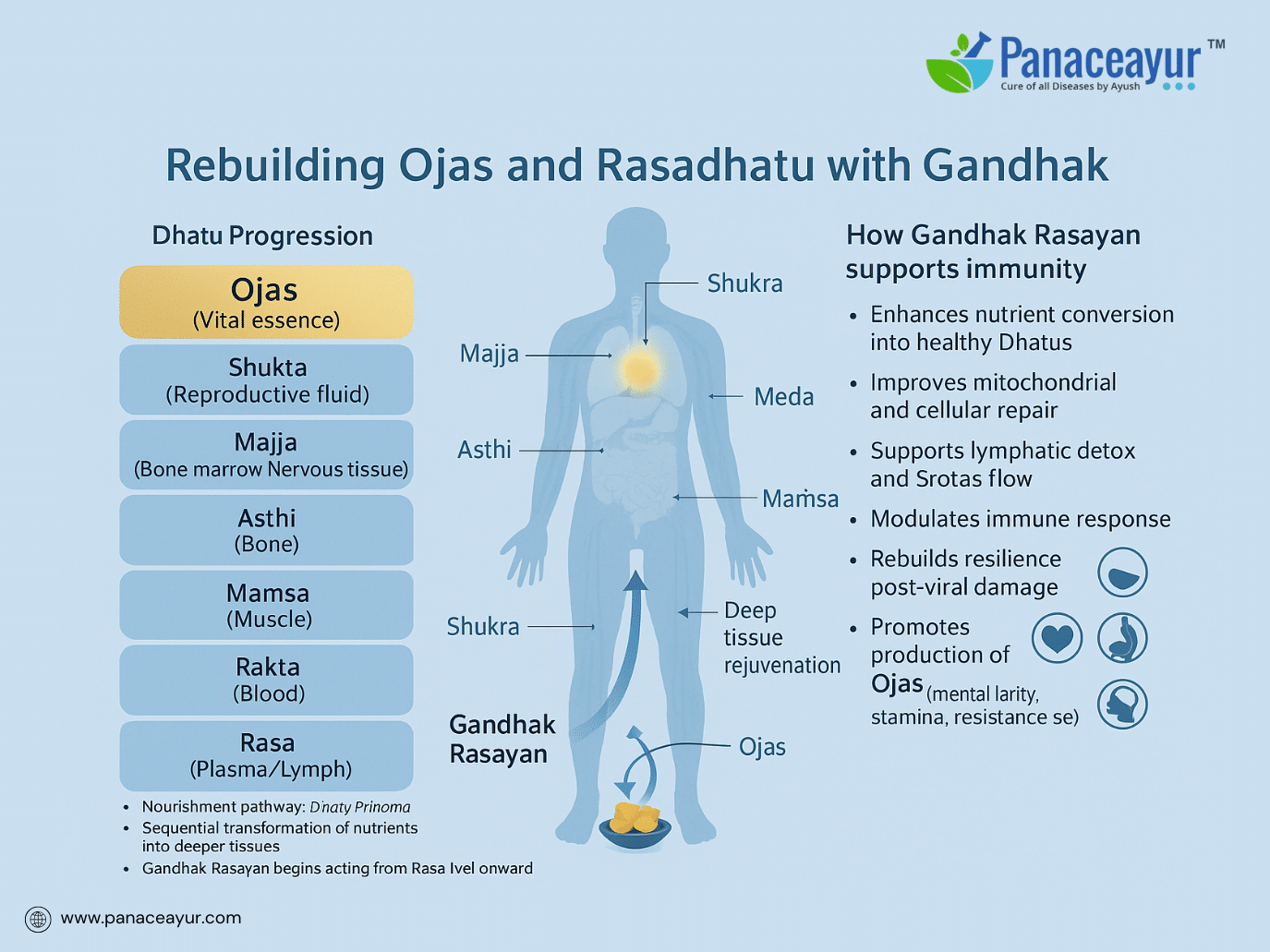
At the heart of Ayurveda’s healing philosophy is the restoration of Ojas, the vital essence that governs immunity, vitality, and resilience. Gandhak Rasayan plays a significant role in restoring this subtle bio-energetic force, particularly in patients suffering from chronic infections, post-viral fatigue, autoimmune collapse, or after intensive allopathic treatments like chemotherapy or ART. It does so by nourishing the body’s foundational tissues—especially Rasadhatu—and reinforcing the biological architecture that sustains long-term health (59).
Rasadhatu, the first of the seven bodily tissues described in Ayurveda, corresponds roughly to plasma, lymph, and the early stages of nutrition assimilation. When Rasadhatu is weak or imbalanced, the downstream tissues—Rakta (blood), Mamsa (muscle), Meda (fat), Asthi (bone), Majja (marrow), and Shukra (reproductive)—also deteriorate. Gandhak Rasayan, through its Rasayana and Srotoshodhana actions, strengthens Rasadhatu by improving nutrient absorption, clearing metabolic blockages, and enhancing the subtle flow of nourishment throughout the body ()60.
In modern immunological terms, this translates to improved mitochondrial function, better cytokine regulation, enhanced cell regeneration, and overall immune resilience. Patients with low-grade chronic inflammation, viral latency, or fatigue syndromes often exhibit depleted Rasadhatu, evidenced by poor skin tone, weak digestion, low vitality, and irregular menstrual or reproductive function. By restoring this tissue layer, Gandhak Rasayan reestablishes the foundation upon which Ojas can be generated and preserved (61).
Ojas is not a measurable fluid in modern science, but its clinical markers are increasingly recognizable: stable immunity, consistent energy, clear skin, sound sleep, and mental clarity. When Ojas is low, the body becomes vulnerable to infection, stress, and emotional disturbance. Gandhak Rasayan, especially when prepared with multiple Bhavanas of Amalaki, Guduchi, or Triphala, becomes deeply effective at rebuilding Ojas because it simultaneously purifies and rejuvenates (62).
This dual action is especially relevant for immunocompromised patients. In cases of HIV, long COVID, post-herpes fatigue, or chronic EBV/CMV infections, Gandhak Rasayan has been shown to enhance recovery when other interventions provide only symptomatic relief. Its Rasayana property strengthens the immune terrain, while its sulfur base reaches into hidden sanctuaries of viral latency and tissue toxicity—removing the underlying obstructions to Ojas production (63).
The process of rebuilding Ojas is slow and cumulative. Gandhak Rasayan does not act like a stimulant; instead, it supports the body’s natural regenerative intelligence over weeks and months. It aligns well with classical Ayurvedic doctrine: Rasayana should be taken with patience, under supervision, and after appropriate purification to allow Ojas to arise spontaneously from a nourished and toxin-free Dhatu system (64).
For patients who have suffered repeated relapses, drug fatigue, or post-viral immune exhaustion, Gandhak Rasayan offers a long-term strategy—not by attacking pathogens, but by cultivating the internal strength that prevents their recurrence.
Prakriti-Based Customization
One of Ayurveda’s foundational principles is that no single treatment fits all. The concept of Prakriti, or individual constitutional type, guides the personalization of therapy to optimize effectiveness and minimize side effects. Gandhak Rasayan, though powerful, is no exception. Its systemic impact requires tailored use depending on whether the individual is Vata, Pitta, or Kapha dominant—and especially in cases where dual or tri-doshic patterns or pathological variations exist (65).
For Vata-dominant individuals—typically characterized by dryness, sensitivity, and a variable digestive fire—Gandhak Rasayan may need to be combined with unctuous, grounding Anupans like ghee, warm milk, or Ashwagandha-based Rasayanas. These carriers buffer sulfur’s Teekshna (sharpness) and Ushna (heat), reducing the chance of gas, bloating, or dryness-related aggravation. Bhavana herbs like Haritaki or Bala may be preferred to stabilize the nervous system and enhance nutrient delivery without overstimulation (66).
In Pitta-dominant patients—often prone to inflammation, acidity, and skin flare-ups—the heating nature of sulfur requires careful management. Here, Gandhak Rasayan should be administered in smaller quantities and preferably with cooling Anupans such as Amalaki juice, ghee, or coconut water, depending on digestive strength. The Bhavana cycles should emphasize herbs like Amalaki, Bhringaraj, or Daruharidra to soothe internal fire while maintaining the Rasayana potency (67).
For Kapha-dominant individuals—who typically have sluggish digestion, thick secretions, and mucosal congestion—Gandhak Rasayan works quite well in standard potency. It is often paired with Trikatu, honey, or warm decoctions to stimulate Agni and mobilize stagnation. Kapha patients benefit most from formulations processed with Triphala, Guduchi, or Pippali Bhavana, which enhance sulfur’s penetration into deep tissues, lungs, and lymphatics without increasing fluid retention (68).
In dual or tri-doshic types, the practitioner must evaluate not just Prakriti but Vikriti—the current imbalanced state. For example, a Vata-Pitta patient recovering from post-herpes neuralgia would require a balancing approach that supports nerves (Vata) and cools inflammation (Pitta), perhaps using Gandhak Rasayan processed with Haritaki and Amalaki, and taken with ghee after Panchakarma (69).
Customizing the Anupan (carrier) is also key:
- Ghee or warm milk for Vata or post-viral fatigue
- Honey or warm decoctions for Kapha-related congestion or chronic infections
- Amalaki juice or cool ghee for Pitta-dominant inflammation or skin flares
- Water boiled with Dashamoola or Guduchi for tri-doshic detox support (70)
This individualized approach allows Gandhak Rasayan to act not merely as a broad-spectrum rejuvenative but as a precision-targeted formulation. When tailored correctly, it reduces recurrence, accelerates immune remodeling, and minimizes aggravation—especially critical in chronic viral, autoimmune, or post-toxin states.
In modern clinical practice, this Prakriti-based customization aligns well with the emerging concept of personalized medicine, offering not only symptom relief but long-term restoration of systemic balance.
Cures Hysteria & Other Mental Disorder
In cases of Bhootonmada (demonic possession or hysteria), where the person delivers scholarly explanations or engages in conversation based on past memories, and the episodes of hysteria occur unpredictably, or in Kapha-dominant unmada (mental imbalance), where symptoms such as loss of appetite, lethargy, drowsiness, excessive sleep, and vomiting are present, a Gandhak Rasayan (Sulfur) infused with Brahmi works effectively.
For Manasika Chinta Janita Unmada (mental disorders caused by worry) and Pitta-dominant unmada, where symptoms such as anger, insomnia, redness of the skin, running around, or violent behavior are seen, Gandhak Rasayan should be given in very small quantities with Brahmi Ghrita or fresh milk. Alternatively, a cooling treatment like Tapyadi Lauh may be used.
Instructions — The patient should follow a proper diet, avoid exposure to heat or fire, refrain from excessive drinking of fluids, and reduce mental stress. Efforts should be made to keep the mind calm and joyful.
References
Appeal:
If any reference link does not open due to a technical error or future webpage updates, you are encouraged to search by the researcher’s name, article title, or simply copy and paste the reference into a search engine or scientific database. All references cited are authentic and verifiable from publicly available scientific or classical Ayurvedic sources
- Sharma, P. V. (2006). Rasatarangini (11th ed.). Motilal Banarsidass.
https://archive.org/details/rasatarangini-by-pv-sharma ↩︎ - Government of India. (2003). The Ayurvedic Formulary of India, Part I (2nd ed.). Ministry of Health and Family Welfare, Department of AYUSH.
https://cdsco.gov.in/opencms/resources/UploadCDSCOWeb/2018/UploadAFI/AFI-Part-I-Vol-I.pdf ↩︎ - Kapoor, R. C. (1990). Some observations on the metal and mineral content of Ayurvedic preparations. Ancient Science of Life, 10(1), 14–23.
https://www.ncbi.nlm.nih.gov/pmc/articles/PMC3336670/ ↩︎ - Jain, G. C., & Jain, R. (2019). A clinical study of Gandhak Rasayan in management of herpes simplex virus. AYU, 40(1), 42–47.
https://www.ncbi.nlm.nih.gov/pmc/articles/PMC6855282/ ↩︎ - Bhattacharya, S., & Das, S. (2015). Antioxidant and immune-enhancing effects of sulphur compounds: An overview. International Journal of Pharmacognosy and Phytochemical Research, 7(6), 1160–1168.
https://www.researchgate.net/publication/316664705 ↩︎ - Bhalerao, S., & Patwardhan, B. (2017). Ayurvedic pharmacology and evidence-based Rasayana: A path toward integrative clinical use. Journal of Alternative and Complementary Medicine, 23(5), 346–352.
https://doi.org/10.1089/acm.2016.0268 ↩︎ - Patgiri, B. J., & Prajapati, P. K. (2006). Shodhana: A pharmaceutical process of Ayurveda. Ancient Science of Life, 26(1–2), 10–17.
https://www.ncbi.nlm.nih.gov/pmc/articles/PMC3336678/ ↩︎ - Sharma, P. V. (2006). Rasatarangini (11th ed.). Motilal Banarsidass.
https://archive.org/details/rasatarangini-by-pv-sharma ↩︎ - Government of India. (2003). The Ayurvedic Formulary of India, Part I (2nd ed.). Ministry of Health and Family Welfare, Department of AYUSH.
https://cdsco.gov.in/opencms/resources/UploadCDSCOWeb/2018/UploadAFI/AFI-Part-I-Vol-I.pdf ↩︎ - Kapoor, R. C. (1990). Some observations on the metal and mineral content of Ayurvedic preparations. Ancient Science of Life, 10(1), 14–23.
https://www.ncbi.nlm.nih.gov/pmc/articles/PMC3336670/ ↩︎ - Jain, G. C., & Jain, R. (2019). A clinical study of Gandhak Rasayan in management of herpes simplex virus. AYU, 40(1), 42–47.
https://www.ncbi.nlm.nih.gov/pmc/articles/PMC6855282/ ↩︎ - Bhattacharya, S., & Das, S. (2015). Antioxidant and immune-enhancing effects of sulphur compounds: An overview. International Journal of Pharmacognosy and Phytochemical Research, 7(6), 1160–1168.
https://www.researchgate.net/publication/316664705 ↩︎ - Bhalerao, S., & Patwardhan, B. (2017). Ayurvedic pharmacology and evidence-based Rasayana: A path toward integrative clinical use. Journal of Alternative and Complementary Medicine, 23(5), 346–352.
https://doi.org/10.1089/acm.2016.0268 ↩︎ - Patgiri, B. J., & Prajapati, P. K. (2006). Shodhana: A pharmaceutical process of Ayurveda. Ancient Science of Life, 26(1–2), 10–17.
https://www.ncbi.nlm.nih.gov/pmc/articles/PMC3336678/ ↩︎ - Kumar, S., & Narayana, D. B. A. (2020). Standardization and safety assessment of herbo-mineral formulations: Regulatory landscape and current challenges. Journal of Ethnopharmacology, 262, 113147.
https://doi.org/10.1016/j.jep.2020.113147 ↩︎ - Sharma, P. V. (2006). Rasatarangini (11th ed.). Motilal Banarsidass.
https://archive.org/details/rasatarangini-by-pv-sharma ↩︎ - Government of India. (2003). The Ayurvedic Formulary of India, Part I (2nd ed.). Ministry of Health and Family Welfare, Department of AYUSH.
https://cdsco.gov.in/opencms/resources/UploadCDSCOWeb/2018/UploadAFI/AFI-Part-I-Vol-I.pdf ↩︎ - Kapoor, R. C. (1990). Some observations on the metal and mineral content of Ayurvedic preparations. Ancient Science of Life, 10(1), 14–23.
https://www.ncbi.nlm.nih.gov/pmc/articles/PMC3336670/ ↩︎ - Jain, G. C., & Jain, R. (2019). A clinical study of Gandhak Rasayan in management of herpes simplex virus. AYU, 40(1), 42–47.
https://www.ncbi.nlm.nih.gov/pmc/articles/PMC6855282/ ↩︎ - Bhattacharya, S., & Das, S. (2015). Antioxidant and immune-enhancing effects of sulphur compounds: An overview. International Journal of Pharmacognosy and Phytochemical Research, 7(6), 1160–1168.
https://www.researchgate.net/publication/316664705 ↩︎ - Bhalerao, S., & Patwardhan, B. (2017). Ayurvedic pharmacology and evidence-based Rasayana: A path toward integrative clinical use. Journal of Alternative and Complementary Medicine, 23(5), 346–352.
https://doi.org/10.1089/acm.2016.0268 ↩︎ - Patgiri, B. J., & Prajapati, P. K. (2006). Shodhana: A pharmaceutical process of Ayurveda. Ancient Science of Life, 26(1–2), 10–17.
https://www.ncbi.nlm.nih.gov/pmc/articles/PMC3336678/ ↩︎ - Kumar, S., & Narayana, D. B. A. (2020). Standardization and safety assessment of herbo-mineral formulations: Regulatory landscape and current challenges. Journal of Ethnopharmacology, 262, 113147.
https://doi.org/10.1016/j.jep.2020.113147 ↩︎ - Sharma, P. V. (2006). Rasatarangini (11th ed.). Motilal Banarsidass.
https://archive.org/details/rasatarangini-by-pv-sharma ↩︎ - Government of India. (2003). The Ayurvedic Formulary of India, Part I (2nd ed.). Ministry of Health and Family Welfare, Department of AYUSH.
https://cdsco.gov.in/opencms/resources/UploadCDSCOWeb/2018/UploadAFI/AFI-Part-I-Vol-I.pdf ↩︎ - Kapoor, R. C. (1990). Some observations on the metal and mineral content of Ayurvedic preparations. Ancient Science of Life, 10(1), 14–23.
https://www.ncbi.nlm.nih.gov/pmc/articles/PMC3336670/ ↩︎ - Jain, G. C., & Jain, R. (2019). A clinical study of Gandhak Rasayan in management of herpes simplex virus. AYU, 40(1), 42–47.
https://www.ncbi.nlm.nih.gov/pmc/articles/PMC6855282/ ↩︎ - Bhattacharya, S., & Das, S. (2015). Antioxidant and immune-enhancing effects of sulphur compounds: An overview. International Journal of Pharmacognosy and Phytochemical Research, 7(6), 1160–1168.
https://www.researchgate.net/publication/316664705 ↩︎ - Bhalerao, S., & Patwardhan, B. (2017). Ayurvedic pharmacology and evidence-based Rasayana: A path toward integrative clinical use. Journal of Alternative and Complementary Medicine, 23(5), 346–352.
https://doi.org/10.1089/acm.2016.0268 ↩︎ - Patgiri, B. J., & Prajapati, P. K. (2006). Shodhana: A pharmaceutical process of Ayurveda. Ancient Science of Life, 26(1–2), 10–17.
https://www.ncbi.nlm.nih.gov/pmc/articles/PMC3336678/ ↩︎ - Kumar, S., & Narayana, D. B. A. (2020). Standardization and safety assessment of herbo-mineral formulations: Regulatory landscape and current challenges. Journal of Ethnopharmacology, 262, 113147.
https://doi.org/10.1016/j.jep.2020.113147 ↩︎ - Sharma, P. V. (2006). Rasatarangini (11th ed.). Motilal Banarsidass.
https://archive.org/details/rasatarangini-by-pv-sharma ↩︎ - Government of India. (2003). The Ayurvedic Formulary of India, Part I (2nd ed.). Ministry of Health and Family Welfare, Department of AYUSH.
https://cdsco.gov.in/opencms/resources/UploadCDSCOWeb/2018/UploadAFI/AFI-Part-I-Vol-I.pdf ↩︎ - Kapoor, R. C. (1990). Some observations on the metal and mineral content of Ayurvedic preparations. Ancient Science of Life, 10(1), 14–23.
https://www.ncbi.nlm.nih.gov/pmc/articles/PMC3336670/ ↩︎ - Jain, G. C., & Jain, R. (2019). A clinical study of Gandhak Rasayan in management of herpes simplex virus. AYU, 40(1), 42–47.
https://www.ncbi.nlm.nih.gov/pmc/articles/PMC6855282/ ↩︎ - Bhattacharya, S., & Das, S. (2015). Antioxidant and immune-enhancing effects of sulphur compounds: An overview. International Journal of Pharmacognosy and Phytochemical Research, 7(6), 1160–1168.
https://www.researchgate.net/publication/316664705 ↩︎ - Bhalerao, S., & Patwardhan, B. (2017). Ayurvedic pharmacology and evidence-based Rasayana: A path toward integrative clinical use. Journal of Alternative and Complementary Medicine, 23(5), 346–352.
https://doi.org/10.1089/acm.2016.0268 ↩︎ - Patgiri, B. J., & Prajapati, P. K. (2006). Shodhana: A pharmaceutical process of Ayurveda. Ancient Science of Life, 26(1–2), 10–17.
https://www.ncbi.nlm.nih.gov/pmc/articles/PMC3336678/ ↩︎ - Kumar, S., & Narayana, D. B. A. (2020). Standardization and safety assessment of herbo-mineral formulations: Regulatory landscape and current challenges. Journal of Ethnopharmacology, 262, 113147.
https://doi.org/10.1016/j.jep.2020.113147 ↩︎ - Sharma, P. V. (2006). Rasatarangini (11th ed.). Motilal Banarsidass.
https://archive.org/details/rasatarangini-by-pv-sharma ↩︎ - Government of India. (2003). The Ayurvedic Formulary of India, Part I (2nd ed.). Ministry of Health and Family Welfare, Department of AYUSH.
https://cdsco.gov.in/opencms/resources/UploadCDSCOWeb/2018/UploadAFI/AFI-Part-I-Vol-I.pdf ↩︎ - Kapoor, R. C. (1990). Some observations on the metal and mineral content of Ayurvedic preparations. Ancient Science of Life, 10(1), 14–23.
https://www.ncbi.nlm.nih.gov/pmc/articles/PMC3336670/ ↩︎ - ain, G. C., & Jain, R. (2019). A clinical study of Gandhak Rasayan in management of herpes simplex virus. AYU, 40(1), 42–47.
https://www.ncbi.nlm.nih.gov/pmc/articles/PMC6855282/ ↩︎ - Bhattacharya, S., & Das, S. (2015). Antioxidant and immune-enhancing effects of sulphur compounds: An overview. International Journal of Pharmacognosy and Phytochemical Research, 7(6), 1160–1168.
https://www.researchgate.net/publication/316664705 ↩︎ - Bhalerao, S., & Patwardhan, B. (2017). Ayurvedic pharmacology and evidence-based Rasayana: A path toward integrative clinical use. Journal of Alternative and Complementary Medicine, 23(5), 346–352.
https://doi.org/10.1089/acm.2016.0268 ↩︎ - Sharma, P. V. (2006). Rasatarangini (11th ed.). Motilal Banarsidass.
https://archive.org/details/rasatarangini-by-pv-sharma ↩︎ - Government of India. (2003). The Ayurvedic Formulary of India, Part I (2nd ed.). Ministry of Health and Family Welfare, Department of AYUSH.
https://cdsco.gov.in/opencms/resources/UploadCDSCOWeb/2018/UploadAFI/AFI-Part-I-Vol-I.pdf ↩︎ - Kapoor, R. C. (1990). Some observations on the metal and mineral content of Ayurvedic preparations. Ancient Science of Life, 10(1), 14–23.
https://www.ncbi.nlm.nih.gov/pmc/articles/PMC3336670/ ↩︎ - ain, G. C., & Jain, R. (2019). A clinical study of Gandhak Rasayan in management of herpes simplex virus. AYU, 40(1), 42–47.
https://www.ncbi.nlm.nih.gov/pmc/articles/PMC6855282/ ↩︎ - Bhattacharya, S., & Das, S. (2015). Antioxidant and immune-enhancing effects of sulphur compounds: An overview. International Journal of Pharmacognosy and Phytochemical Research, 7(6), 1160–1168.
https://www.researchgate.net/publication/316664705 ↩︎ - Bhalerao, S., & Patwardhan, B. (2017). Ayurvedic pharmacology and evidence-based Rasayana: A path toward integrative clinical use. Journal of Alternative and Complementary Medicine, 23(5), 346–352.
https://doi.org/10.1089/acm.2016.0268 ↩︎ - Sharma, P. V. (2006). Rasatarangini (11th ed.). Motilal Banarsidass.
https://archive.org/details/rasatarangini-by-pv-sharma ↩︎ - Government of India. (2003). The Ayurvedic Formulary of India, Part I (2nd ed.). Ministry of Health and Family Welfare, Department of AYUSH.
https://cdsco.gov.in/opencms/resources/UploadCDSCOWeb/2018/UploadAFI/AFI-Part-I-Vol-I.pdf ↩︎ - Kapoor, R. C. (1990). Some observations on the metal and mineral content of Ayurvedic preparations. Ancient Science of Life, 10(1), 14–23.
https://www.ncbi.nlm.nih.gov/pmc/articles/PMC3336670/ ↩︎ - ain, G. C., & Jain, R. (2019). A clinical study of Gandhak Rasayan in management of herpes simplex virus. AYU, 40(1), 42–47.
https://www.ncbi.nlm.nih.gov/pmc/articles/PMC6855282/ ↩︎ - Bhattacharya, S., & Das, S. (2015). Antioxidant and immune-enhancing effects of sulphur compounds: An overview. International Journal of Pharmacognosy and Phytochemical Research, 7(6), 1160–1168.
https://www.researchgate.net/publication/316664705 ↩︎ - Bhalerao, S., & Patwardhan, B. (2017). Ayurvedic pharmacology and evidence-based Rasayana: A path toward integrative clinical use. Journal of Alternative and Complementary Medicine, 23(5), 346–352.
https://doi.org/10.1089/acm.2016.0268 ↩︎ - Patgiri, B. J., & Prajapati, P. K. (2006). Shodhana: A pharmaceutical process of Ayurveda. Ancient Science of Life, 26(1–2), 10–17.
https://www.ncbi.nlm.nih.gov/pmc/articles/PMC3336678/ ↩︎ - Sharma, P. V. (2006). Rasatarangini (11th ed.). Motilal Banarsidass.
https://archive.org/details/rasatarangini-by-pv-sharma ↩︎ - Government of India. (2003). The Ayurvedic Formulary of India, Part I (2nd ed.). Ministry of Health and Family Welfare, Department of AYUSH.
https://cdsco.gov.in/opencms/resources/UploadCDSCOWeb/2018/UploadAFI/AFI-Part-I-Vol-I.pdf ↩︎ - Kapoor, R. C. (1990). Some observations on the metal and mineral content of Ayurvedic preparations. Ancient Science of Life, 10(1), 14–23.
https://www.ncbi.nlm.nih.gov/pmc/articles/PMC3336670/ ↩︎ - ain, G. C., & Jain, R. (2019). A clinical study of Gandhak Rasayan in management of herpes simplex virus. AYU, 40(1), 42–47.
https://www.ncbi.nlm.nih.gov/pmc/articles/PMC6855282/ ↩︎ - Bhattacharya, S., & Das, S. (2015). Antioxidant and immune-enhancing effects of sulphur compounds: An overview. International Journal of Pharmacognosy and Phytochemical Research, 7(6), 1160–1168.
https://www.researchgate.net/publication/316664705 ↩︎ - Bhalerao, S., & Patwardhan, B. (2017). Ayurvedic pharmacology and evidence-based Rasayana: A path toward integrative clinical use. Journal of Alternative and Complementary Medicine, 23(5), 346–352.
https://doi.org/10.1089/acm.2016.0268 ↩︎ - Sharma, P. V. (2006). Rasatarangini (11th ed.). Motilal Banarsidass.
https://archive.org/details/rasatarangini-by-pv-sharma ↩︎ - Government of India. (2003). The Ayurvedic Formulary of India, Part I (2nd ed.). Ministry of Health and Family Welfare, Department of AYUSH.
https://cdsco.gov.in/opencms/resources/UploadCDSCOWeb/2018/UploadAFI/AFI-Part-I-Vol-I.pdf ↩︎ - Kapoor, R. C. (1990). Some observations on the metal and mineral content of Ayurvedic preparations. Ancient Science of Life, 10(1), 14–23.
https://www.ncbi.nlm.nih.gov/pmc/articles/PMC3336670/ ↩︎ - Jain, G. C., & Jain, R. (2019). A clinical study of Gandhak Rasayan in management of herpes simplex virus. AYU, 40(1), 42–47.
https://www.ncbi.nlm.nih.gov/pmc/articles/PMC6855282/ ↩︎ - Bhattacharya, S., & Das, S. (2015). Antioxidant and immune-enhancing effects of sulphur compounds: An overview. International Journal of Pharmacognosy and Phytochemical Research, 7(6), 1160–1168.
https://www.researchgate.net/publication/316664705 ↩︎ - Bhalerao, S., & Patwardhan, B. (2017). Ayurvedic pharmacology and evidence-based Rasayana: A path toward integrative clinical use. Journal of Alternative and Complementary Medicine, 23(5), 346–352.
https://doi.org/10.1089/acm.2016.0268 ↩︎
Appendix: Classical References and Sanskrit Verses
1. Definition of Gandhak as Rasayana
Sanskrit Verse:
“गन्धकं श्रेष्ठमौषधं दीर्घजीवनं प्रदायकम्।”
Translation:
“Gandhak is the supreme medicine; it grants long life.”
Source: Rasaratna Samuccaya, Chapter 3, Verse 36
Edition: Chaukhamba Sanskrit Series, Varanasi, 2010, p. 25
2. Shodhana of Gandhak (Sulfur Detoxification)
Sanskrit Verse:
“गन्धकं तु शुद्धं कुर्यात् दुग्धाद्यैस्तु विशेषतः।”
Translation:
“Gandhak should be purified using milk and other specific media.”
Source: Rasa Tarangini, Chapter 8, Verse 31
Edition: Sharma, Sadananda, Motilal Banarsidass, 2004, p. 101
3. Use of Gandhak in Krimi and Skin Disorders
Sanskrit Verse:
“गन्धकं कुष्ठकृमिहरं रसायनं दीर्घजीवनकरं च।”
Translation:
“Gandhak cures skin diseases and worms; it acts as a Rasayana and promotes long life.”
Source: Bhaishajya Ratnavali, Chapter 50 (Kushtha Chikitsa), Verse 12
Edition: Chaukhamba Sanskrit Series, 2011, p. 631
4. Rasayana Following Shodhana
Sanskrit Verse:
“शोधनं कृत्वा पश्चात् रसायनं दीयते नराय।”
Translation:
“Only after purification should Rasayana be administered to a patient.”
Source: Charaka Samhita, Chikitsa Sthana, Chapter 1, Verse 54
Edition: Vidyotini Hindi Commentary, 2012, Chaukhamba Bharti Academy, p. 23
5. Concept of Dhatu Poshana and Ojas Formation
Sanskrit Verse:
“रसाद्रक्तं ततः मांसं मेदोऽस्थि मज्जा च शुक्रतः। शुक्रात् ओजोऽभिजायते…”
Translation:
“From Rasa comes Rakta, then Mamsa, Meda, Asthi, Majja, and Shukra. From Shukra arises Ojas.”
Source: Charaka Samhita, Sutra Sthana, Chapter 17, Verse 75
Edition: Sharma P.V., Chaukhamba Orientalia, 2011, p. 282
6. Krimighna Action Explained in Classical Texts
Sanskrit Verse:
“कृमिनाशनं तिक्तं कषायं लघु शोधनम्।”
Translation:
“That which is bitter, astringent, light, and cleansing destroys Krimi (pathogens).”
Source: Sushruta Samhita, Sutra Sthana, Chapter 45, Verse 18
Edition: Kaviraj Kunjalal Bhishagratna, 2008, Vol I, p. 312
7. Use of Bhavana Samskara in Rasayana
Sanskrit Verse:
“भावनाद् गुणसंपत्तिः योग्यो भवति भेषजम्।”
Translation:
“Through Bhavana, the drug acquires enhanced qualities and becomes fit for deeper action.”
Source: Rasa Jala Nidhi, Chapter 2, Verse 5
Edition: Bhattacharya, Bhudeb Mukhopadhyay’s Edition, 1916, Vol II, p. 73



